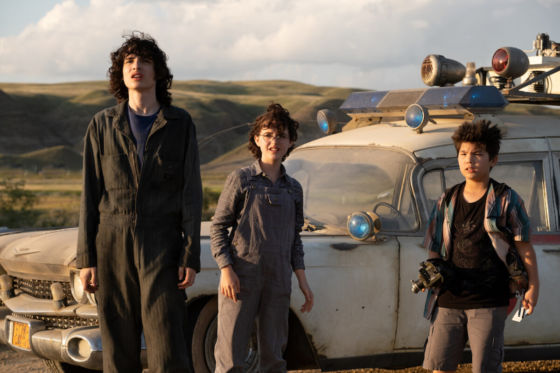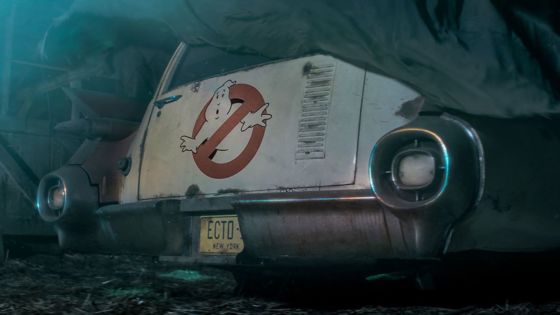Ghostbusters: Afterlife – Review

1984’s Ghostbusters was an early example of the months-long hype process that seems to be de rigueur with most tentpole films these days. Y’know, where posters and teasers start whetting the audience’s appetite so far in advance of the final product’s release? Well before June 8, 1984, moviegoers started seeing this odd poster with the universal “NO” emblem holding back a puffy, hunched-over ghost.

As history has borne out, Ghostbusters was a welcome example of a movie living up to said hype. After one direct sequel and an alternate-universe remake, its fans rightly hold the original as the gold standard for the series. The second direct sequel, Ghostbusters: Afterlife, goes in an entirely different direction, opting more for emotional thematic material than reaching into a ready bucket of laughs.

What’s funny is that this film is made for the same audience who made Ghostbusters the top-grossing comedy of the 1980s. The kids who saw it in its original run are now adults with their own children; some might have followed similar tracks as the family at the epicenter of this new film. And for certain, most of us by now have been bitten hard by personal loss and tragedy.

But the film also carries with it a voice for the children of these now-adults, extending them a hand into the world their parents loved when they were young. That co-writers Gil Kenan and Jason Reitman (who also directs) could straddle this divide with both arms outstretched on either side to welcome both generations is exactly why Ghostbusters: Afterlife is a wild success. It’s not just a smart move; it’s the only move this film could have made if it stood a chance at being good.

Of course, with the film’s director being the successful son of the original film’s director, there was every confidence that Jason Reitman would make a worthy successor to his father’s original. He has paid back this confidence by making a film that simultaneously punches our nostalgia buttons with grace, forges a new path with a younger audience, and also has a way of making us feel that we’re not alone. The in-universe timeline started in 1984 has grown up along with us, with every bit of our triumphs and failures reflected in this film’s story and themes; it seems to be saying, “We know and we’ve got you, ‘cause we’re there, too.”

To newcomers, they’ll get right behind the two children dragged from their New York City apartment by their just-evicted single mother who’s inherited a strange-looking farmhouse in the middle of nowhere, Ohio. Both Mckenna Grace (Phoebe) and Finn Wolfhard (Trevor) are known to younger audiences for being featured in popular television shows such as “Once Upon a Time” and “Stranger Things,” respectively. There’s a built-in trust we have with these actors that this film respects and serves well, putting them squarely in the “hero” seat and letting them be our guides through their new adventure.

While Trevor’s a reasonably typical 15-year-old (read: more concerned with looking cool for his friends and the girls), Phoebe’s got more brains than heart, her decisions and speech being more cerebral than Trevor’s see-a-girl-and-apply-for-a-job-at-the-same-place-she’s-working choices. Between the two of them, there are many opportunities for humor and smarts, equaling a similar balance found in the original between the four Ghostbusters.

So while Trevor’s off doing boy things, Phoebe starts taking a look around the house, soon finding her deceased grandfather’s scientific equipment and suddenly playing chess with a literal ghost. No self-respecting Ghostbuster would be anything without a team, right? Enter the spunky, always-on podcaster named, well, Podcast (Logan Kim) and inquisitive science teacher Chad Grooberson (Paul Rudd), who help unravel the mystery surrounding Phoebe’s new house and the lineage of its former occupant.

Well, it’s not really a mystery to us – the cold open makes it clear who lived in the house before the kids and their mother Callie (Carrie Coon) moved in. What’s not clear is what he was doing there and what he was trying to achieve in his short appearance, a hook that sinks deep into us by having the movie unfold just as the original did. Quick glimpses of the big picture slowly drop into place until it is fully formed; by then, we’ve eagerly fallen in love with the story and where Phoebe’s discoveries are taking us.

Ghostbusters: Afterlife is also equal parts remake, as there’s a familiar figure at the center of it all, with familiar machinations and familiar settings. One has to wonder if the film’s actual theme is cemented by the director’s chair being taken over by Jason Reitman and that Hollywood is, in fact, devoid of new material, with the new generation merely following in the footsteps of the old. While Phoebe has the capacity to match her grandfather in scientific talent, she doesn’t have to create anything for herself; she mostly just has to fix what he did before. In this, the film does lose a step, and we can’t help but think about the kind of postmodern shade Jason Reitman seems to knowingly throw at himself.

However, if he wanted to do a straight-up remake, he’d have filled it with more humor and hijinks. Instead, there’s a more grounded tale being spun, possibly having to do with more personal subjects like growing up with paternal estrangement and the loss of a loved one. Through Callie, these concepts are explored as an annoyance, having to pick up after the sudden hermit father who disappeared from her life. But through Phoebe and Trevor, we experience the side of grief that sank us into total detachment or made us start exploring the family history to understand the deceased a little bit better.

This is adventure on a grandly rural scale, with the New York skyline replaced by a one-stoplight town, rolling hills, cornfields, and mountains. A perfect place to relive a childhood wish – to be a kid member of the Ghostbusters. Many of us dressed up in coveralls and fashioned homemade versions of the Proton Packs and Particle Throwers ‘cause they didn’t sell them back then, right? How cool would it have been to wield that kind of tech as a kid? This movie’s for all of us who had those adventures in our heads, ripping around our towns in the ECTO-1 with Proton Streams flying everywhere. We get to see those daydreams realized as Phoebe takes up the mantle left by the original Ghostbusters, relegated to being a footnote in history.

Kenan and Reitman’s script wisely pays homage to the original and invites new franchise viewers with a fresh riff on a continuing legend. Newcomers and original devotees will be joined in a way that most remakes and reboots have lacked. Scores of older films are brought into the 21st century by new chapters that don’t take the time to reach out to their original fans or do so perfunctorily with a post-ironic, cynical, backhanded manner. You can see and feel a palpable love for the original and its fans imparted in every frame, performance, and action sequence; some may call this “fanservice,” and it might be.

But there’s more than fanservice going on. There’s a genuine embrace of the past with an equally genuine look at the future, and it’s difficult to pull off without needing to pander to one side or the other. Jason Reitman has done the impossible, uniting both old and new in a satisfying, rather touching way. It’s not a constant laugh parade like the first, as that’s not its goal. Rest assured, the comedy is there, but this is more of an emotional reckoning rather than a chucklefest.

It’s emotional because the subject matter demands it, especially after the 2014 death of Harold Ramis, who played original Ghostbuster Egon Spengler. This film honors him and makes his presence – and that of Egon’s as well – the lead character, an unusual choice that pays off in every way possible. With Ramis and Egon come the messages of hope amid ruin and love for one’s family (both blood and through battle) that transcends death. That is why Ghostbusters: Afterlife was the sequel we needed, deserved, and finally received.
MPAA Rating: PG-13 for supernatural action and some suggestive references.
Contains mid- and post-credits scenes.
Running time: 125 minutes.
Released by Sony Pictures Releasing/Columbia Pictures.
Ghostbusters: Afterlife
Rating
4.5 Stars
Jason Reitman has done the impossible, uniting both old and new in a satisfying, rather emotional way.










